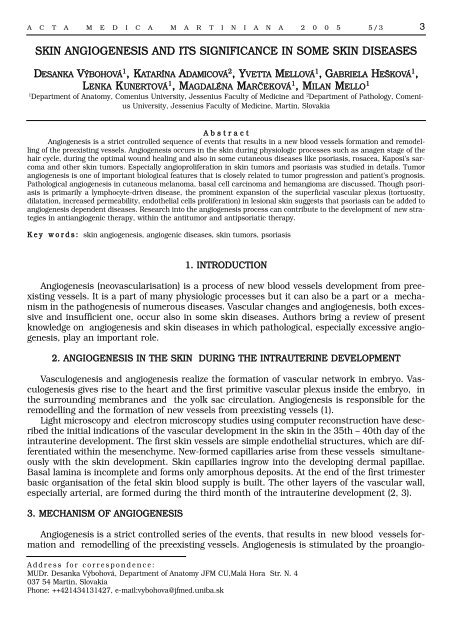MAKETA 5/3
MAKETA 5/3
MAKETA 5/3
You also want an ePaper? Increase the reach of your titles
YUMPU automatically turns print PDFs into web optimized ePapers that Google loves.
A C T A M E D I C A M A R T I N I A N A 2 0 0 5 5/3 3<br />
SKIN ANGIOGENESIS AND ITS SIGNIFICANCE IN SOME SKIN DISEASES<br />
DESANKA VÝBOHOVÁ 1 , KATARÍNA ADAMICOVÁ 2 , YVETTA MELLOVÁ 1 , GABRIELA HEŠKOVÁ 1 ,<br />
LENKA KUNERTOVÁ 1 , MAGDALÉNA MARČEKOVÁ 1 , MILAN MELLO 1<br />
1<br />
Department of Anatomy, Comenius University, Jessenius Faculty of Medicine and 2 Department of Pathology, Comenius<br />
University, Jessenius Faculty of Medicine, Martin, Slovakia<br />
A b s t r a c t<br />
Angiogenesis is a strict controlled sequence of events that results in a new blood vessels formation and remodelling<br />
of the preexisting vessels. Angiogenesis occurs in the skin during physiologic processes such as anagen stage of the<br />
hair cycle, during the optimal wound healing and also in some cutaneous diseases like psoriasis, rosacea, Kaposi’s sarcoma<br />
and other skin tumors. Especially angioproliferation in skin tumors and psoriasis was studied in details. Tumor<br />
angiogenesis is one of important biological features that is closely related to tumor progression and patient’s prognosis.<br />
Pathological angiogenesis in cutaneous melanoma, basal cell carcinoma and hemangioma are discussed. Though psoriasis<br />
is primarily a lymphocyte-driven disease, the prominent expansion of the superficial vascular plexus (tortuosity,<br />
dilatation, increased permeability, endothelial cells proliferation) in lesional skin suggests that psoriasis can be added to<br />
angiogenesis dependent diseases. Research into the angiogenesis process can contribute to the development of new strategies<br />
in antiangiogenic therapy, within the antitumor and antipsoriatic therapy.<br />
K e y w o r d s : skin angiogenesis, angiogenic diseases, skin tumors, psoriasis<br />
1. INTRODUCTION<br />
Angiogenesis (neovascularisation) is a process of new blood vessels development from preexisting<br />
vessels. It is a part of many physiologic processes but it can also be a part or a mechanism<br />
in the pathogenesis of numerous diseases. Vascular changes and angiogenesis, both excessive<br />
and insufficient one, occur also in some skin diseases. Authors bring a review of present<br />
knowledge on angiogenesis and skin diseases in which pathological, especially excessive angiogenesis,<br />
play an important role.<br />
2. ANGIOGENESIS IN THE SKIN DURING THE INTRAUTERINE DEVELOPMENT<br />
Vasculogenesis and angiogenesis realize the formation of vascular network in embryo. Vasculogenesis<br />
gives rise to the heart and the first primitive vascular plexus inside the embryo, in<br />
the surrounding membranes and the yolk sac circulation. Angiogenesis is responsible for the<br />
remodelling and the formation of new vessels from preexisting vessels (1).<br />
Light microscopy and electron microscopy studies using computer reconstruction have described<br />
the initial indications of the vascular development in the skin in the 35th – 40th day of the<br />
intrauterine development. The first skin vessels are simple endothelial structures, which are differentiated<br />
within the mesenchyme. New-formed capillaries arise from these vessels simultaneously<br />
with the skin development. Skin capillaries ingrow into the developing dermal papillae.<br />
Basal lamina is incomplete and forms only amorphous deposits. At the end of the first trimester<br />
basic organisation of the fetal skin blood supply is built. The other layers of the vascular wall,<br />
especially arterial, are formed during the third month of the intrauterine development (2, 3).<br />
3. MECHANISM OF ANGIOGENESIS<br />
Angiogenesis is a strict controlled series of the events, that results in new blood vessels formation<br />
and remodelling of the preexisting vessels. Angiogenesis is stimulated by the proangio-<br />
Address for correspondence:<br />
MUDr. Desanka Výbohová, Department of Anatomy JFM CU,Malá Hora Str. N. 4<br />
037 54 Martin, Slovakia<br />
Phone: ++421434131427, e-mail:vybohova@jfmed.uniba.sk
















